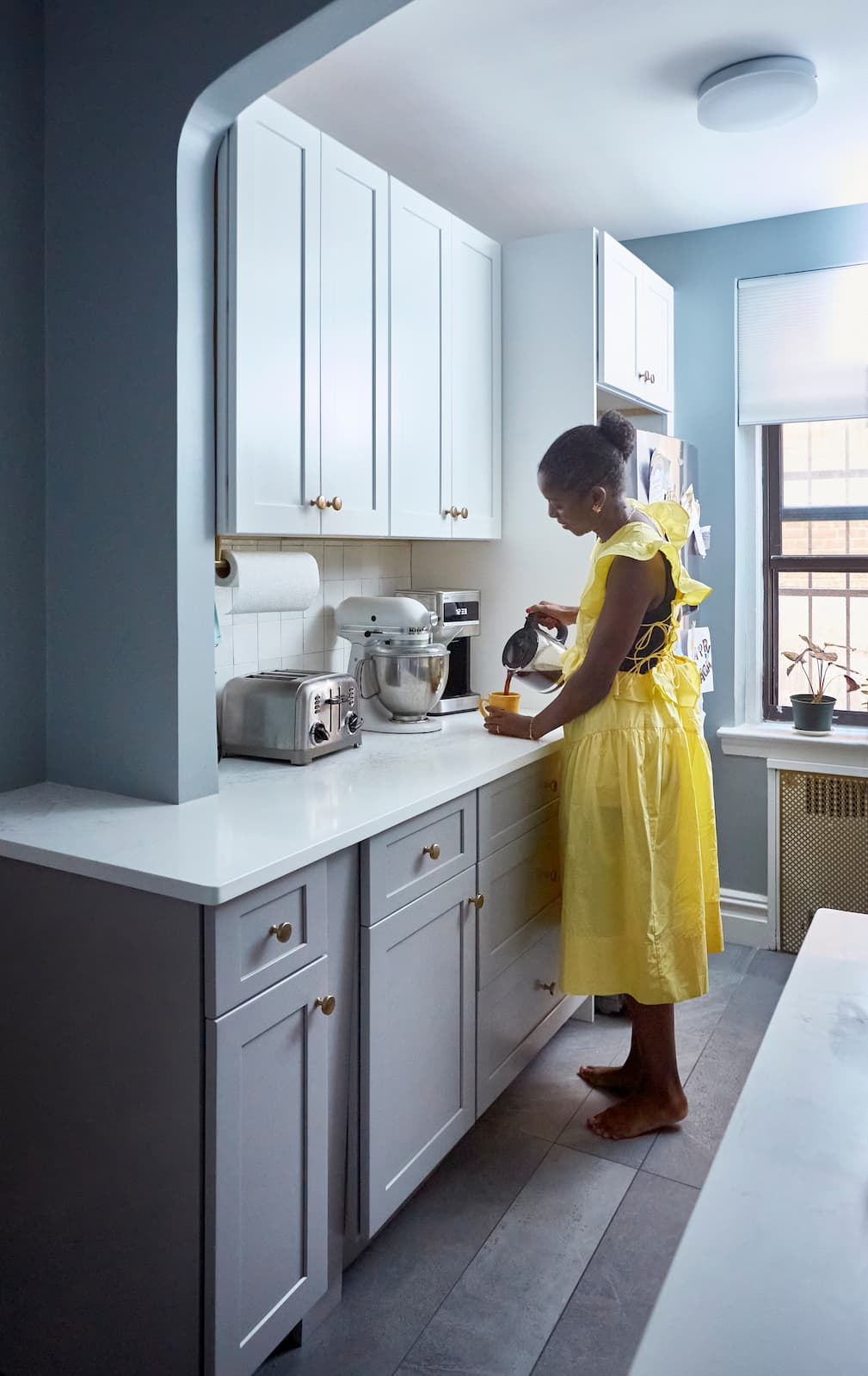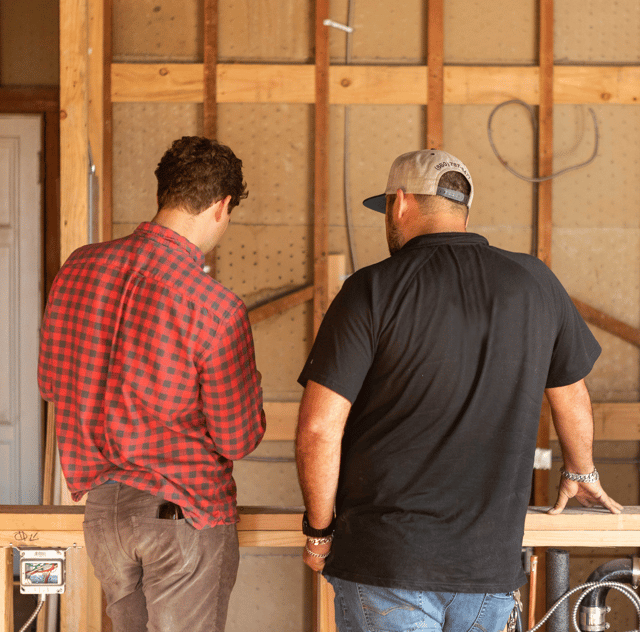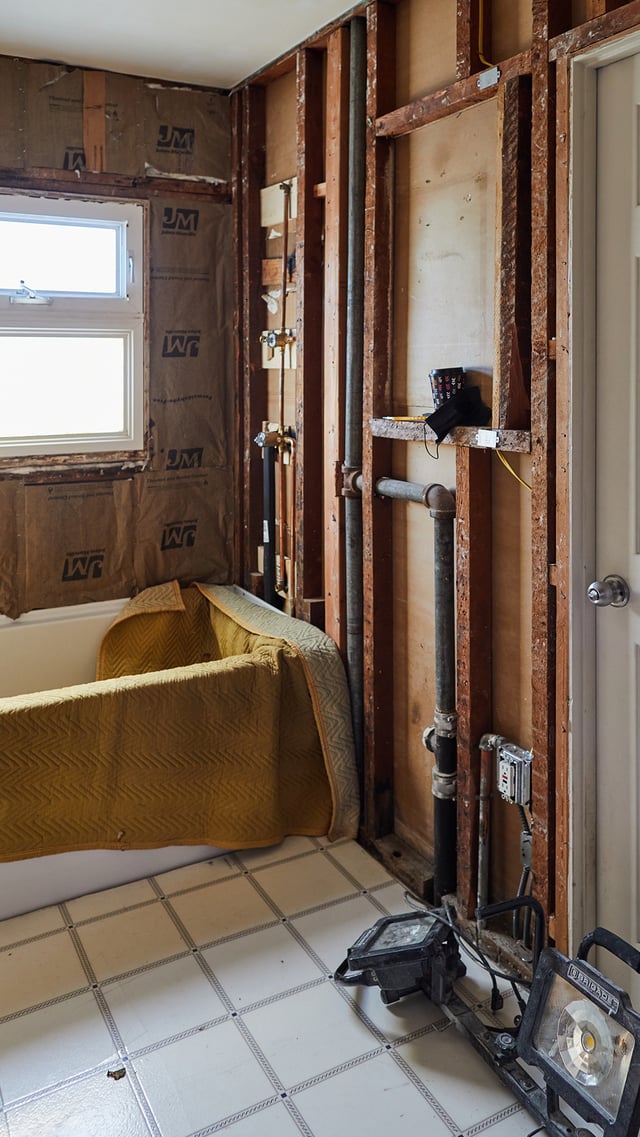
Working with Contractors
The Block Way of Renovating: A Complete Homeowner’s Guide
11.24.2025


In This Article
Ever caught yourself daydreaming about transforming your home into something extraordinary? You’re not alone—it’s a journey filled with excitement and a sprinkle of nerves! But don’t worry! In this guide, we'll walk through the steps to confidently tackle your home renovation, keeping things simple and clear. Whether it’s a new kitchen, a cozy living room, or a fresh facade, let’s get started!
Renovate with confidence every step of the way
Step 1: Personalize Your Renovation Plan
Step 2: Receive Quotes from Trusted Contractors
Step 3: Let Us Handle the Project Details

A complete home remodel means transforming almost every part of your home. It’s not just about painting a few walls or changing the flooring. Instead, it involves reimagining and reconstructing spaces to fit your family's current needs and style preferences. Everything from the kitchen and bathrooms to the living room and bedrooms can be reworked.
Different Components: Interior and Exterior
When we talk about remodeling, it's essential to think about both the interior and the exterior of your home. Inside, you might consider:
For the exterior, a complete remodel might include:
Know the Cost Before You Start

Structural or Cosmetic Changes
In a full home remodel, you might come across two types of changes:

Thinking about diving into a complete home remodel but not quite sure if it’s worth it? Let's explore the exciting benefits that come with transforming your entire living space.
Increases Home Value
One of the biggest perks of a complete home remodel is the potential increase in your home's market value. By upgrading and modernizing various aspects of your house, you not only make it more appealing to potential buyers down the line but also boost its resale value. This can make your home a solid investment for the future.
Enhances Aesthetic Appeal
Imagine walking into a home that truly reflects your style and taste. A complete remodel gives you the opportunity to create a cohesive and beautiful space that you and your family will love. Whether it’s a sleek, modern kitchen or a cozy, inviting living room, refreshing your home's appearance can make every day feel a little more special.
Improves Functionality
Another significant benefit is the improvement in your home’s functionality. As your lifestyle or family needs change, adjusting the layout and features of your home can make daily life more convenient and enjoyable. Whether it's adding storage space, optimizing room layouts, or enhancing energy efficiency, a remodel allows you to tailor your home to better suit your needs.
When it comes to a whole house remodel, the possibilities are vast and exciting. Here are some inspiring examples to get those creative juices flowing:
1. Vintage Charm Revamp
Imagine taking an older home with vintage charm and updating it for modern living while still preserving its character. This might involve:
If you love the idea of open spaces, consider transforming a segmented layout into an open-concept design:
Renovating a home is like putting together a jigsaw puzzle—each piece must fall into place in the correct order to create a seamless result. Following a planned sequence not only makes the process smoother but also helps avoid unnecessary costs and delays.
|
Step
|
Description
|
|
1. Pre-Construction Planning
|
Start with detailed planning and design. Obtain necessary permits to ensure everything is up to code.
|
|
2. Core Structural Repairs
|
Address any foundational or structural issues, such as roofing or water damage, to ensure safety.
|
|
3. Plumbing, Electrical, and HVAC
|
Upgrade or install essential systems to avoid future disruptions or damages to finished areas.
|
|
4. Interior Transformation
|
Focus on reconfiguring spaces, installing insulation, drywall, and then painting and flooring.
|
|
5. Exterior Work
|
Finalize with exterior updates like siding, windows, and outdoor spaces to boost curb appeal.
|
Starting with pre-construction planning ensures your renovation journey is on the right track. Begin by shaping your vision, gathering inspiration from various sources, and crafting detailed plans. Collaborating with professionals like architects can help refine your design and ensure everything is laid out accurately.
Securing permits is a critical next step to keep your project compliant with local building codes. Establish a realistic budget that includes materials, labor, and a safety net for unexpected costs. This preparation not only streamlines the process but also sets the foundation for a successful renovation.
Once the planning stage is complete, it's crucial to focus on core structural repairs to ensure your home's stability and safety. This step involves addressing the most essential elements of your house, setting the stage for all following upgrades. Start by examining the roofing, which protects your home from the elements. If needed, replace or repair your roof to prevent leaks and water damage. Additionally, inspect the foundation for any cracks or weaknesses, as these can lead to major issues if left untreated. Tackling these structural changes first ensures a strong and secure base for the rest of your renovation journey.
Plumbing, Electrical, and HVAC
After solidifying your home's structure, the next step is to turn your attention to the essential systems that keep your home running smoothly. This involves evaluating and updating the plumbing, electrical, and HVAC systems to ensure efficiency and safety. Consider whether your plumbing needs an upgrade to handle modern appliances or increased water usage. Similarly, check your electrical system to support new technology and prevent overloads, potentially rewiring if necessary. Lastly, assess your HVAC units; energy-efficient models not only improve comfort but also reduce utility costs. Upgrading or replacing these systems early in the renovation process prevents future disruptions and aligns everything with modern standards.
With the essentials sorted, it's time to refresh your home's interior, focusing on walls, floors, and cabinetry. Start by updating the walls with new paint or a tweaked layout for a more open feel. For floors, choose from tile, hardwood, or carpet to dramatically alter the look of the space. Lastly, improve kitchens and bathrooms with new or refinished cabinets, enhancing both style and function.
Finally, it's time to boost your home's curb appeal with some attention to the exterior. This phase includes updates that not only enhance aesthetic appeal but also add value to your property. Begin with a fresh coat of paint to give the outside a clean, updated look. Then, focus on landscaping to create welcoming and attractive outdoor spaces with greenery and flowers. Additionally, consider other enhancements like updating siding or windows to improve both the appearance and efficiency of your home. These changes wrap up your renovation, ensuring your home is not only beautiful inside but also impressive on the outside.
A well-organized plan is key to embarking on a successful home renovation journey. Here's a step-by-step guide to help you set clear goals, maintain a budget, and achieve the dream space you envision.
Design a Home That’s Uniquely Yours
Block can help you achieve your renovation goals and bring your dream remodel to life with price assurance and expert support.
Get Started
Start your renovation journey by clearly defining your objectives. Think about what you need most, whether it's more space for growing children, a modernized kitchen, or energy-efficient upgrades. Understanding your priorities helps shape the direction of your project and ensures your efforts align with your lifestyle needs.
Next, consider the vision you have for your space and how it reflects your personal style. Creating a list of must-haves versus nice-to-haves can guide decision-making along the way. With well-defined goals, you'll have a roadmap for your renovation, making it easier to manage choices and stay focused throughout the process.
Crafting a well-planned budget is crucial in managing your renovation expenses. Start by outlining estimated costs for materials, labor, and any professional services you might need, such as architects or designers. This gives you a clear picture of where your money will go and helps prevent overspending.
Don’t forget to set aside a contingency fund for hidden costs that often pop up, like unexpected repairs or design changes. For instance, if your renovation budget is $50,000, allocating 10-20% for surprises means setting aside $5,000 to $10,000. This cushion helps keep your project on track without financial stress, ensuring you can handle unforeseen challenges with ease.
In the exciting phase of gathering inspiration, explore various sources to spark your creativity. Look through home design magazines, websites, and platforms like Pinterest to find styles and elements that resonate with your vision. Visiting showrooms or open houses can also offer a tangible sense of what different materials and designs look like in real spaces. Create an inspiration board to collect and organize your favorite ideas, whether digital or physical. This visual collection helps clarify your design preferences and serves as a handy reference when discussing options with contractors or designers. With a clear sense of style and direction, you’ll be better prepared to create a cohesive and personalized renovation plan.
Establishing a realistic timeline is essential for keeping your renovation on track and reducing stress. Begin by determining the start and end dates for your project, considering availability of materials and any potential delays. Communicate clearly with your contractors to align on achievable timelines and milestones.
Example Timeline:
By mapping out a clear timeline, you'll ensure a smoother renovation process and have a better chance of staying within your desired timeframe.
Selecting the right contractor is vital for ensuring a successful renovation. Start by researching local contractors, reading reviews, and asking for recommendations from friends or neighbors who have recently completed similar projects. Make a shortlist of potential candidates who have the experience and expertise suited to your specific renovation needs. Once you have a few potential contractors, conduct interviews to assess their communication style, professionalism, and understanding of your vision. Don’t hesitate to ask for references and view their previous work to gauge their quality. You should also do a contractor license check to ensure legitimacy. By thoroughly vetting your contractor, you'll feel assured in your choice, knowing your project is in capable hands.
Getting ready for a renovation involves more than just clearing rooms; it means prepping your home and family for the changes ahead. Start by removing personal items and valuables from areas that will be under construction to protect them from dust and potential damage. You might also consider setting up a temporary kitchen or living space if the renovation affects essential areas like these. Additionally, prepare your family for the upcoming changes in routine and environment. Discuss potential disruptions and create a plan to manage noise, dust, and access to certain parts of the home. With proper preparation, you can minimize the impact of the renovation on daily life and ensure a smoother process for everyone involved.
As your renovation nears completion, it's important to have a cleanup plan in place to quickly restore order to your home. Decide whether you’ll handle the cleanup yourself or hire professional cleaning services to tackle the dust and debris left behind. Professionals can make the process faster and more thorough, giving you peace of mind. If you opt for a DIY cleanup, gather necessary supplies such as protective gear, vacuum cleaners with HEPA filters, and heavy-duty trash bags. Begin with a detailed checklist to ensure nothing is overlooked, from cleaning windows and floors to dusting fixtures and vent covers. By planning your cleanup in advance, you’ll transition smoothly from renovation chaos to enjoying your refreshed space.
Creating a detailed renovation plan allows you to visualize the entire process from start to finish, helping ensure every aspect is carefully considered. Here's an example of how a complete home renovation plan might look, incorporating all the steps discussed:
Detailed Renovation Plan Example:
|
Phase
|
Tasks & Details
|
Estimated Duration
|
|
Pre-Construction Planning
|
|
2 weeks
|
|
Budget Preparation
|
|
1 week
|
|
Selecting Contractors
|
|
3 weeks
|
|
Core Structural Repairs
|
|
3 weeks
|
|
Plumbing, Electrical, HVAC
|
|
3 weeks
|
|
Interior Transformation
|
|
4 weeks
|
|
Exterior Work
|
|
2 weeks
|
|
Finalize and Cleanup
|
|
1 week
|
|
Post-Renovation Adjustments
|
|
Ongoing |
Turn your renovation vision into reality
Get matched with trusted contractors and start your renovation today!
Find a Contractor
In wrapping up your home renovation journey, remember that thorough planning and strategic execution are key to achieving the space of your dreams. With a clear plan and the right team, you can navigate each phase confidently, transforming your home into a reflection of your lifestyle and preferences. Enjoy the results of your efforts—a beautiful, functional space crafted for you and your family.

Written by Block Renovation
How long should it take to renovate a house?
What is considered a major remodel?
What is the most expensive part of remodeling a house?
How do I live in my home during renovation?
How can I increase the return on investment (ROI) with my renovation?

Renovate confidently with Block
Easily compare quotes from top quality contractors, and get peace of mind with warranty & price protections.
Thousands of homeowners have renovated with Block

4.5 Stars (100+)

4.7 Stars (100+)

4.5 Stars (75+)

Working with Contractors
The Block Way of Renovating: A Complete Homeowner’s Guide
11.24.2025

Working with Contractors
Steps to Vetting a General Contractor
11.04.2025

Process
Gutting a Bathroom: What It Entails, Costs & Timeline
07.15.2025

Planning & Logistics
How to Start Planning a Home Renovation
04.28.2025

Kitchen
How Long Does a Kitchen Remodel Take?
04.01.2025
Renovate confidently